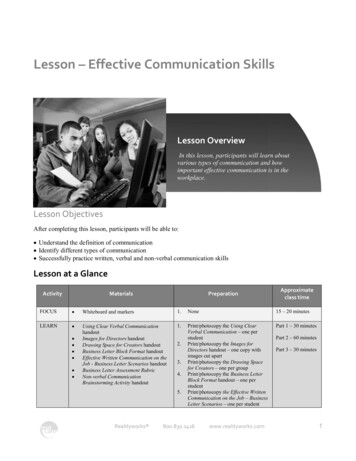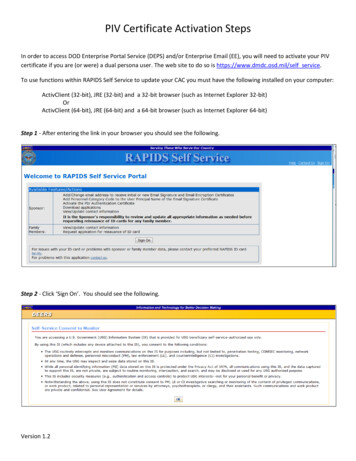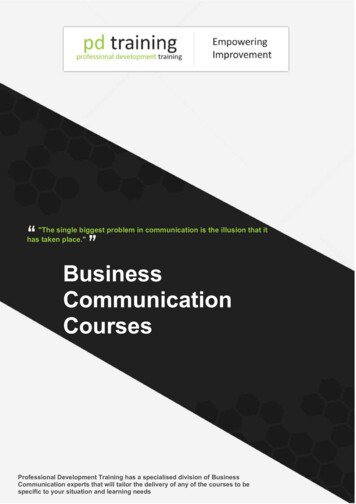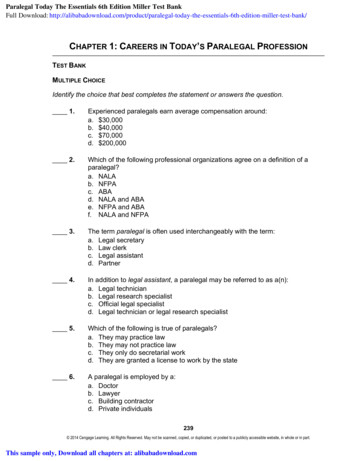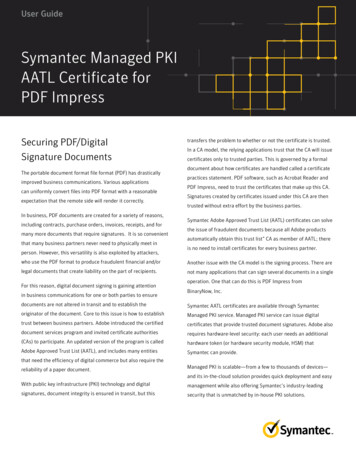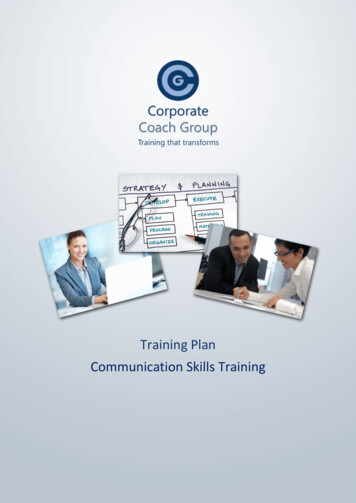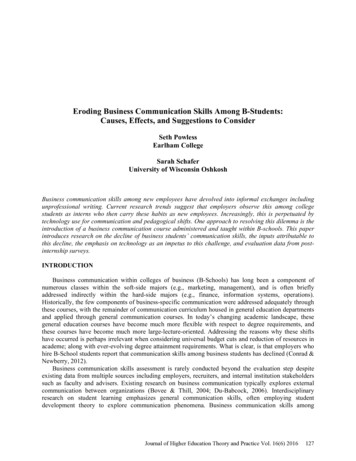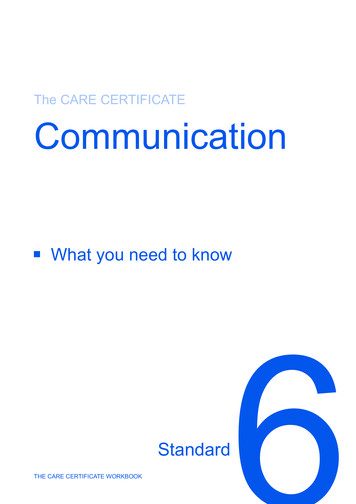
Transcription
The CARE CERTIFICATECommunicationWhat you need to knowStandardTHE CARE CERTIFICATE WORKBOOK
The importanceof effectivecommunicationGood communication developsyour knowledge and understandingabout individuals and the partplayed by other workers so that thebest care and support possible canbe provided. It helps build workingrelationships where each person’sviews are valued and taken intoaccount.CommunicationCommunication is an essential part of a caring relationship and helps to encouragetrusting relationships with other workers and families as well as the individuals youcare for.Types of communicationTalking is often seen as the most common method or type of communication but mostcommunication is silent. Gestures, tone of voice, grins, grimaces, shrugs, nods, movingaway or closer, crossing arms and legs all tell us far more than words. Learning to takeaccount of these reactions is all part of developing your communication skills to achievethe best outcomes for individuals. Communication can be harder when we can’t see thesesigns such as when we use the phone, texts or email.THE CARE CERTIFICATE WORKBOOK STANDARD 6691
Different people have different ways of communicating that work best for them. Some ofthe different types of communication are:Verbal communication - Differences in how you speak, including the tone, pitch,speed and volume of your voice could change how your messages are taken in.Try to avoid using jargon or abbreviations and complicated words and terminology.Make sure you always speak in a respectful way, adjusting your speech to suit theindividual.Sign language - This is a recognised language throughout the world. British SignLanguage (BSL) is used by individuals in this country and there are variations of signlanguage in different regions.Makaton - This is a form of language that uses a large collection of signs andsymbols. It is often used with those who have learning and physical disabilities, orhearing impairment.Braille - Is a code of raised dots that are ‘read’ using touch. For people who arevisually impaired or who are blind, the system supports reading and writing.Body language – This is a type of nonverbal communication. There are manydifferent aspects of body language, including gestures, facial expressions, eyecontact, body positioning and body movements. Each of these will communicateinformation about an individual or a worker often without them realising it.Gestures – These are hand or arm movements that emphasise what is being said orused as an alternative to speaking.Facial expressions – These support what is being said by showing reactions orfeelings. They can give you valuable clues that you can use to check out aperson’s feelings.Eye contact - Maintaining good eye contact is an important way for a worker toshow that they are engaged and listening.Position - The way that we stand, sit or hold our arms when we are talking willprovide others with clues about our feelings, attitude and emotions.Written communication - This method is used to send messages, keep records, orprovide evidence.Communication with other workers and individualsWorkers will develop many different relationships. Some will be formal and others moreinformal. Successful two-way communication is crucial in both cases. A relationship basedon trust and understanding from the beginning will provide the basis for good care andsupport whether short or long-term.Poor communication can quickly lead to confusion and distress. The process ofexchanging information through communication is not always straightforward. If theinformation shared is inaccurate or misleading, mistakes can be made which can result inpoor care.THE CARE CERTIFICATE WORKBOOK STANDARD 62
FormalFormal communication is likely to be used in the working environment, particularlybetween you and other workers.InformalInformal communication is likely to be used with friends and family, using familiarwords or slang.You should always use the communication method that is appropriatefor the person and situation.You should watch for clues from any individual that come from unspoken messages.These non-verbal ways of communicating come from body language, position, facialexpressions or gestures. For example, when asking someone if they are in pain, theymay say ‘no’ but a wrinkled brow, uncomfortable facial expression or body movement maysay otherwise. As an observant worker you will be able to notice when an individual isbecoming confused, angry, upset, stressed or anxious without them telling you. You canthen take action to help stop this from happening or help them express their feelings in thebest way for them.By noticing an individual’s reactions you can ask yourself the following questions:Do I need to change the type of communication I am using to help the individualunderstand?Do I need to be aware of how the conversation is affecting them?Is there something that the individual is not communicating to me that may help?Recognising the unspoken messages can help you to ask good questions and developsupportive relationships. It improves trust as the individual can see that you are interestedin them and trying to understand and meet their needs.THE CARE CERTIFICATE WORKBOOK STANDARD 63
Communication and language needs, wishes and preferencesTo find out what an individual needs or wants, so your work can be centred on them asa person, you have to connect with them. So that means that you must understand theircommunication needs right from the outset.People’s unique communication needs vary depending on their ability, disability, illnessor condition, as well as on their personal preferences. If you can’t find out from talkingand listening how a person needs to communicate, you will need to use other methodsof communication to help them get information across to you in a way that works best forthem. The individual’s family, friends or carer might be able to share experience of whichcommunication methods work best—but sometimes part of the problem is that they don’tcommunicate well with the person being supported, so don’t rely on this method alone.Communicating by touch or physical contactThe individual’s preferences are particularly important in relation to using touch as part ofnon-verbal communication. Touching a person might be done as a form of communication,for example shaking hands or kissing. But other types of touch will almost certainlyalso communicate something to them, for example what they experience from the waysthat they are physically helped to stand or sit or turn over in bed, and particularly theirexperience of being touched in the course of intimate personal care such as washing.In all cases, how you touch anyone must be decided thoughtfully and in a person-centredway. So your use of touch may well be different from one person to the next, and will besomething that you will need to talk about with each person whom you are helping sothat you know their particular preferences. This is also a key area to talk about with yourmanager and work colleagues, especially if you are supporting anyone who cannot clearlycommunicate their own preferences to you.On the whole, any form of touch must be consented to by both people. But sometimes itmay be necessary to touch someone when they do not want to be touched, for example ifthey need to be physically restrained for their own or someone else’s safety. You must talkwith your manager about what are the agreed ways of working in your workplace so youknow what to do if this happens.Remember too that the use of touch must be within the rules for infection control in yourworkplace.See also Care Certificate standards 7 (Privacy and dignity) and 15 (Infection preventionand control).Some specialist methods of communicationTouch is used in particular ways to communicate with people who are deaf and visuallyimpaired. Workers sign information onto the individual’s hands as a way of passing oninformation.THE CARE CERTIFICATE WORKBOOK STANDARD 64
For those whose communication skills may be limited, technological aids can be used.Hearing aids, hearing loops, text phones, text messaging on mobile phones and magnifiersare all forms of technological communication devices.Some individuals may use word or symbol boards to support their speech and/or theirunderstanding. This helps the listener by to associating a picture or printed word with theverbal communication in order to be able to understand what is being said.Others may use speech synthesisers, which replace speech either by producing a visualdisplay of written text or by producing synthesised speech that expresses the informationverbally. Voice recognition software can be purchased for computers (including manytablet ‘pad’ computers with touch screens) to translate speech to written text or the otherway around. Some word-processing programs and apps have this already built in.When using communication aids always check that they function properly, that they areclean and in good working order. Should you have any worries about communication aidsor technology not working properly, or being unclean, report this to a senior member ofstaff or the individual’s carer or family member.Barriers to effective communicationA barrier is anything that will get in the way of communication. There are a wide range ofbarriers including:Attitude – When a worker is abrupt due to time limits, not having enough resources ortheir mood, the person they are speaking to may feel intimidated or frustrated and not wantto communicate.Limited use of technology – When the technological aids known to be the best way forsomeone to communicate are not available.Body positioning – Sitting too close could be intimidating and would make an individualfeel uncomfortable. Sitting too far away could show lack of interest or concern.Emotions – When someone is depressed, angry, embarrassed or upset their emotionsmay affect their ability to think and communicate in a sensible way.Physical – When someone has physical conditions that create communication difficulties,for example, being breathless, not having any teeth or being in pain.Not enough time – Not giving individuals time to say what they want may make them feelrushed and reluctant to express their true wishes.Poor or negative body language – Crossed arms or legs, poor facial expressions, poorbody positioning, constant fidgeting or looking at a watch or mobile phone can all makesomeone less likely to communicate.Lack of privacy – Think carefully about where and when private and confidentialconversations should take place.Stereotyping – Generalisations about a group of people that are wrong and misleading.An example would be that ‘all older people are hard of hearing’.Other barriers include sensory impairments, culture, language, noise, lighting or substancemisuse.THE CARE CERTIFICATE WORKBOOK STANDARD 65
Reducing barriers to communicationAs a worker you should do what you can to reduce any barriers to communication. Themost effective way to make sure that you are meeting someone’s communication needsand providing person-centred care is to know as much as possible as you can about them.A ‘communication passport’ might be used by some which provides vital informationabout their needs, wishes and preferences. This pulls together the information into aformat that is easy to read, often with pictures and photographs. Putting something likethis together with an individual can be another good way of getting to know them welland understanding their needs. Your organisation might have a suggested format but at asimple level you can put one together with the individual to suit them.It is important to get regular feedback about your communication style and methods fromthe people you provide care and support to so that you can continue to improve how youcommunicate. You could also increase your awareness of different communication needsand methods through taking up learning opportunities. Experience will help you to developa variety of new methods of communication and selecting the best one in each situation.Be creative. Open body language and a positive, non-judgemental attitude will further helpreduce barriers. Your communication skills should be seen as a toolbox, using the right toolfor the right job and choosing a different tool if one doesn’t work well.Checking understandingChecking that communication has been understoodis an essential part of the process. A vital skill thatchecks understanding is summarising. A summaryshould bring together the main points of an exchangeof information. This will allow the individual to correctyou if necessary. This can help you to check that youhave correctly understood. Questions are another wayof checking whether a message has been received.Make sure you ask questions in a way that theindividual has to provide a detailed response (openquestions), rather than asking questions which requireonly a ‘yes’ or ‘no’ reply (closed questions). Forexample: ‘What do you like to do in your spare time?’However, closed questions can be useful in somesituations.SummariseThis means to think about the main points of the conversation or communication andshorten or simplify them in order to repeat them back to the individual. This will help tocheck your and their understanding.THE CARE CERTIFICATE WORKBOOK STANDARD 66
Additional information and supportInformation and support on particular communications needs can be found from specialistcharities and associations, especially those specialising in particular disabilities or medicalconditions. Websites can provide material on forums, services or groups in the local areathat you could attend or use to find out more.In addition, some local charities offer specific human aids such as befrienders, advocatesor mentors. A befriender could support an individual in overcoming emotional difficultiesthat are a barrier to their communication. An advocate could communicate on anindividual’s behalf if their skills are very limited.A number of additional key experts available to support individuals with theircommunication needs include speech and language therapists, interpreters, translators,and clinical psychologists or counsellors. Further learning can come from other workers,your manager and a wide range of courses and qualifications.ConfidentialityConfidentiality is an essential principle in health and social care and forms the basis of allways of working and codes of practice. The basis of a good working relationship is trust.This is dependent on the individual being confident that personal information about them istreated confidentially. Information about someone must only be shared with others involvedin their care and support on a ‘need-to-know’ basis. Any information should not usuallybe disclosed without the person’s informed consent. The circumstances when informationmust be shared even if the individual does not give consent are listed later in this section.Informed consentTo give informed consent the individual must be provided with all of the necessaryinformation in order to make a considered decision. See standard 9 for furtherinformation about consent and informed consent.An individual’s right to confidentiality also means that a person’s notes or details mustalways be stored securely, for example in a locked cupboard, and not be left where theycan be seen by unauthorised people. Computers or mobile devices such as electronictablets need to be protected by a password and firewall. When talking about an individualyou must ensure no others can overhear you.It is essential that you obey the laws about confidentiality, particularly:General Data Protection Regulation 2016 – which place obligations on organisationsto process personal data securely. This includes protecting people’s privacy, givingindividuals the right to consent to data collection and the right to have data removed.THE CARE CERTIFICATE WORKBOOK STANDARD 67
Human Rights Act 1998 – This Act determines a number of basic rights for any citizen ofthe UK. The important one in this context is the right to respect for private and family life,home and 2/contentsYou must find out from your manager what your workplace’s agreed ways of working arefor putting these laws and other aspects of confidentiality into practice.Limits to confidentialityWhenever possible, individuals should provide their consent for the transfer of information.However, this may not always be possible and there will be occasions when informationnormally considered confidential needs to be shared. Examples of occasions whenconfidentiality may have to be broken are:a person is likely to harm themselvesa person has been, or is likely to be, involved in a serious crimea person is likely to harm othersyour safety is placed at riska child or vulnerable adult has suffered, or is at risk of suffering, significant harm.There will be times when you face dilemmas about confidentiality, not knowing what to door if you should speak to anyone about the information you have. At these times itis important to speak with your manager and follow the agreed ways of working. If yourmanager is not available, a senior member of staff or other worker should be able to help.See also Care Certificate standard 14 (Handling information).Communication in summaryCommunication may take place face-to-face, by telephone or text, by email, internet orsocial networks, by written reports or letters. It requires you to listen or read (andunderstand) as well as to speak or write. Whether you are communicating face-to-face,on the telephone or in written form, always be respectful, try to match your method ofcommunication to the individual’s needs and be aware of confidentiality.THE CARE CERTIFICATE WORKBOOK STANDARD 68
The CARE CERTIFICATECommunicationWhat do you know now?StandardTHE CARE CERTIFICATE WORKBOOK
Activity 6.1aCommunicationChoose five different typesof communication anddescribe how and whenthey might be used.TypeDescribe - to describe means to create apicture with words but not simply writinga list of bullet points.How and when it could be used1.2.3.4.5.THE CARE CERTIFICATE WORKBOOK STANDARD 610
Activity 6.1bUse examples from yourown workplace to describehow good and poorcommunication could affectrelationships at work.Describe - to describe means to create apicture with words but not simply writinga list of bullet points.1. Examples of good communication affecting a work relationship:2. Examples of poor communication affecting a work relationship:THE CARE CERTIFICATE WORKBOOK STANDARD 611
Activity 6.1cImagine you are talking to anindividual about a change to theircare plan. During the conversation,which starts very relaxed, you noticethat the person starts getting fidgetyand avoiding eye contact. Theirbody language changes, they turnsideways on their chair so they nolonger face you.1. Why is it important that you notice the changes in the other person’s reactions?2. Why is it important that you respond to the changes in the other person’sreactions?THE CARE CERTIFICATE WORKBOOK STANDARD 612
Activity 6.2aPart i) Use the spiderdiagram to list four waysthat can help you toestablish an individual’scommunication or languageneeds, wishes andpreferences.List: to list means to write in bullet pointsor provide short answers that are straightto the point.Ways that can helpme to establishcommunicationlanguageneeds, wishes &preferencesTHE CARE CERTIFICATE WORKBOOK STANDARD 613
Activity 6.2aPart ii) Describe how eachof the above can help youto establish an individual’scommunication andlanguage needs, wishesand preferences.Describe: to describe means to createa picture with words but not simply writinga list of bullet points. Include details likewhy and how.1234THE CARE CERTIFICATE WORKBOOK STANDARD 614
Activity 6.2bThink of the different communicationneeds, wishes and preferences thatindividuals may have. Completethe diagram below to list at leastsix different styles or methods ofcommunication that could helpyou when communicating withindividuals. An example has beenprovided for you.List: to list means to write inbullet points or provide shortanswers that are straight to thepoint.TouchCommunicationstyles andmethods that helpto meet needs,wishes andpreferencesTHE CARE CERTIFICATE WORKBOOK STANDARD 615
Activity 6.3a & bComplete the table belowto make a list of potentialbarriers to effectivecommunication anddescribe ways to reducethe barrier. An example hasbeen provided for you.Describe: to describe means to createa picture with words but not simply writinga list of bullet points. Include details likewhy and how.Barrier to communicationHow it can be reduced1. Substance misuseIf an individual’s behaviour is affected because of misuseof substances, I need to think carefully about how I willuse my communication skills to make sure the individualis supported. If they are frustrated and angry I will need touse a calming tone of voice and relaxed body languagebut maintain a safe distance.2.3.4.5.THE CARE CERTIFICATE WORKBOOK STANDARD 616
Activity 6.3cDuring any conversation ordiscussion, you would like to knowthat you have got your point acrossto the other person or people, andthat they know or understand whatyou mean. How could you checkto make sure that the other personunderstands what you are saying?THE CARE CERTIFICATE WORKBOOK STANDARD 617
Activity 6.3dThink of an individual or group ofindividuals in your workplace thatyou might struggle to communicatewith. Make sure you respectconfidentiality by not using theirname. Who could help you withinformation, support or services tocommunicate more effectively? Howcould they help?The example from my place of work I have chosen is:I could find information and support or services from:They could help me to:THE CARE CERTIFICATE WORKBOOK STANDARD 618
Activity 6.4aIn your own words,describe the meaning ofconfidentiality in relationto your job role. You mightuse your contract or jobdescription to help you.Describe: to describe means to createa picture with words but not simply writinga list of bullet points. Include details likewhy and how.In my job role as , confidentialitymeans:THE CARE CERTIFICATE WORKBOOK STANDARD 619
Activity 6.4bFamiliarise yourself withyour workplace’s agreedways of working in relationto confidentiality. Completethe table below to listlegislation and agreedways of working to maintainconfidentiality in your dailyroutines.Agreed ways of working: this refers to companypolicies and procedures.This includes those lessformally documented by individual employers and theself-employed as well as formal policies such as theDignity Code, Essence of Care and Compassion inPractice.List: to list means to write in bullet points or provideshort answers that are straight to the point.LegislationAgreed ways of workingTHE CARE CERTIFICATE WORKBOOK STANDARD 620
Activity 6.4cAt times you may come acrosssituations where you need toshare confidential information,even if the individual doesn’twant you to. Give threeexamples of situations that mighthappen in your workplace whereinformation might need to bepassed on to other key people.Example 1:Example 2:Example 3:THE CARE CERTIFICATE WORKBOOK STANDARD 621
Activity 6.4dImagine one of the situationsyou have described in thelast task happens whilst youare on duty. Who could youask for advice and supportabout confidentiality? Andhow would they be able tohelp you?People I could ask:They could help me with advice and support because:THE CARE CERTIFICATE WORKBOOK STANDARD 622
feelings. They can give you valuable clues that you can use to check out a person’s feelings. Eye contact - Maintaining good eye contact is an important way for a worker to show that they are engaged and listening.

